#I had to ~summarize Matt's description because
Text

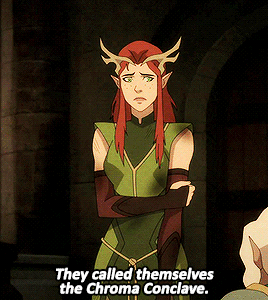





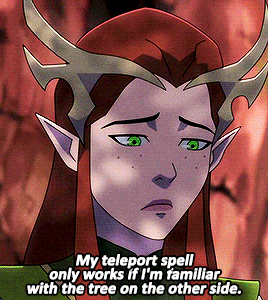


The Legend of Vox Machina Season 2: From Table to TV
#criticalroleedit#critteredit#tlovmedit#critical role#the legend of vox machina#keyleth of the air ashari#mgifs#from table to tv#C1E40 2h28m35s#C1E40 2h44m#C1E41 18m#C1E60 2h17m37s#C1E44 1h30m41s#I had to ~summarize Matt's description because#the text wouldn't have fit in the gif otherwise#but you get the gist of it#anyway I'd never done this type of gifset before#it was fun! so I'll maybe do more in the future :D
2K notes
·
View notes
Text
(going to try not to spend too much time perfecting this and just say whatever comes to mind)
so like I legitimately do want to try out Tumblr Live for real but:
all of the missing integrations with the rest of the site aside (some will be addressed, I'm sure, who knows to what degree in the end), the actual reason I can't figure out how to use the damn thing and why I think it feels so foreign to much of the Tumblr userbase is that
there are no real descriptions of what the streams are about? the UI is clearly focused on profile pictures, and those profile pictures are mostly faces. the culture the Livebox software is seemingly optimized to facilitate making connections in—and I'm basically direct-quoting Meet Group's public mission statement stuff on their website to try to see it from their side—has an obvious focus on what you look like that Tumblr's established culture for the most part doesn't. this is fine(ish) in and of itself as an addition to the other things the Tumblr community focuses on. if I had to try and summarize in literally five seconds, I would say Tumblr is about sharing the things you like, the things you care about, and sometimes the things you do and make. go look at the current Tumblr Live (Livebox) UI and zoom all the way out: where is there space for those things? currently, there isn't any, though there is a big focus on tips:


now, listen: I'm (kind of) a developer. I get it. you build the user experience you want out of the tools you have, and you can't wait to ship until what you've built is a flawless expression of your vision for your product. I don't think the decision makers at the top of Tumblr think that an unmodified out-of-the-box Livebox integration is exactly what they think Tumblr needs (both to be a better product and to stop losing money). I have more faith in them than that, and you should too if you want to think about these things in any even vaguely productive way. (let's ignore the possibility that the "stop losing money" side of things heavily outweighs the "make a good product" side due to financials; as a) if that's true, we're screwed regardless, and b) I hope Matt has enough cash to be able to burn a whole bunch for a while to try to save the only good large social media site on the web; if so, thanks Matt, I owe ya one.)
but if we're actually engaging with this line of thinking, that of course means that as a decision maker, you only partner with meet group if they have something you want and couldn't more efficiently make yourself. that happens all the time! there's going to be a trade-off there. that's fine! you paid the price of "this white-label UI isn't well-suited to my website at all*" and you got something valuable in exchange.
*I have no qualms about stating this as an objective, undisputed truth; it's possible some would disagree and that's fair.
now, what I'm thus forced to speculate about is... what did Tumblr get out of the exchange? if I had to guess, the things Tumblr would not have if Matt was just like "guys please implement the same feature set as Livebox" would be like a) a bunch of livestreaming code because that stuff is a pain in the ass, b) a bunch of hosting services (Live is on another domain so I assume Livebox hosts it?), c) some amount of expertise in—I guess—monetizing parasocial relationships via microtransactions? and d) some cash up front probably. (edit: also, moderation tools/services; those are big.)



now, if I'm right about all of that, and admittedly it's not all that well-educated of a guess... then, you know, sure. I just hope everyone's on the same page re: which of those things are the benefits and which are the costs. I'm happy for "the social network that I like but which costs more to run than it makes even with what I feel from the outside is not much development staff at all" to have some more money, and I'm happy for said development staff not to have to spend their time setting up RTMP servers or whatever; that's boring as hell and a waste of everyone's time, I'd imagine.
but in the bigger picture—again we are ignoring the "oh god cash" possibility—you pull the trigger on a bet like this because you think the resources will help you build something that's, well, uniquely Tumblr. you already paid someone to try and elucidate what that means:
You'll make friends. You'll fall in love. You'll make enemies. You'll become unrecognizable to your friends and family. They'll worry about you. You'll be okay. You're on Tumblr.
Every video you find, every quote you reblog, every tag you curate, every waterfall GIF you secretly gaze at in wonder—that's all you. You're the explorer. We're just a map you all keep on making. Welcome home. Welcome to weird. Make it yours.
if I were a product manager, my giant whiteboard would have "click the square with the person's face and see ways to tip them" on the left, and "you'll make friends / you'll fall in love / you'll make enemies / you'll become unrecognizable to your friends and family" on the right, and a whole bunch of arrows and question marks in the middle.
and yeah, I guess from my perspective, the thing that makes Tumblr Live interesting is that, presuming that some of that middle part of the whiteboard starts to get filled in, I am fascinated to watch how it does. and I think you have to acknowledge that a) they will actually try it and b) they have a nonzero chance of success, if you want to say actually meaningful things about Live as a feature.
(I was primarily excited for the feature to come to desktop web because that had the potential to add a lot to step one of this, on my imagined version of the whiteboard. yes, the vast majority of tumblr users use the apps, us desktop web traditionalists have to acknowledge that... but I would also imagine that a significant amount of the content creators who drive all of this engagement are on desktop, and in my mind "you can share what you are doing in your computer" is the path to a lot more compelling, Tumblr-y live content than "point your phone camera at something"—essentially, in the grand scheme of things I imagine desktop web Live as the source of the content you view on iOS/Android Live, and I would love to know if the Live team has that thought as well.)
1 note
·
View note
Text
New Amsterdam Chapter 80
Matt sighed at the sound of crunching glass and took off his glasses to rub at his eyes. “Elektra,” he said identifying her particular scent of ozone, gun oil, and leather, “I am working.”
Foggy, asleep on the other side of the table, managed to snort anyway.
“There are monsters roaming the streets,” Elektra said bluntly as she leaned against the table, making it shake.
Matt carefully grabbed the edge of the table with one hand and the paperwork in the other. Whatever idiot had translated this contract to braille for him had refrained from putting page numbers in the corners and he was not going through all of this again! “Go tell the Avengers,” he said absently as he followed the contract. Hmm. Mr. Landlord was going to have a lot to answer for—but he finally knew why all of this had landed on his client. Parker was the only tenant in the building with fixed rent, and the values for that plot of land had gone up.
“Your law partner is drooling,” Elektra informed him.
“Happens when he falls asleep with his mouth open,” Matt replied absently as he continued going through the contract.
“The Avengers won’t listen to me. According to their fancy computers, I’m dead.”
Matt paused and frowned. That—was a problem. Elektra had died. Legally, she’d been dead three times, in actuality it was only two. Then again, it was the Avengers. Matt snorted. “It’s not like they don’t have experience with people coming back from the dead,” he told her.
Foggy hummed and smacked his lips before his breathing evened out again.
“Are you sure he’s asleep?” Elektra asked. He heard the sound of flesh moving.
“Elektra, stop poking my associate. Why are you here?”
“There are monsters roaming the streets.”
Matt sighed. “Allow me to rephrase. Why are you here, at my office, during the day when I have work? Legal work,” he added.
He heard her sigh as the table shifted under her weight when she leaned on it. “I got hired by this guy who was panicking. He’d done the paperwork and paid for a woman—said it was his girlfriend, sister-in-law, or something—and two kids to come to the States.”
“People disappear in foreign countries all the time,” Matt said absently as he sorted the paperwork. He was going to leave work early. He knew it. He didn’t have to have the powers of one of Xavier’s people to be able to tell, to feel the tides as they washed away at him.
“They didn’t disappear in the other country. They didn’t disappear on the way over. In fact, they made it to the NA Airstrip whole, healthy, and with a shit ton of baggage, according to the tapes.”
Matt stopped what he was doing and turned his head to her as his nostrils flared, trying to get the scent of this case. “Oh?” he asked calmly.
“Then, the airport was attacked. Spiderman and the Avengers showed, beat the bad guys, SHIELD took custody of the mutants, blah blah blah,” Elektra summarized. “Point is, the three went missing during the confusion.”
Matt turned to her warily. “What were you paid to do?” he asked curiously.
She snorted. “Find the kids. He doesn’t care much one way or the other about the woman, but he wants to make sure the kids are safe. He’s got someone sitting on him so I don’t have to worry about him endangering anyone or anything.”
“And the children?” Matt prompted.
“Are with the rest of the street children, wherever they are,” Elektra said. “I’ve been assured they’re safe,” she added.
Matt could hear a mixture of respect and worry in her voice. “Assured by whom?” he asked.
“I don’t know. She didn’t introduce herself and Matt—this girl is good. I didn’t even know she was there until she spoke.”
Matt frowned as Foggy let out another snort and mutter. Elektra had been trained by the best. Matt knew this, because they’d helped train him too. Like Matt, it was almost impossible to sneak up on her. Almost. He knew of two people who could do it, and neither of them warranted the description “girl.”
Elektra, having given him a moment to mull that over, spoke again. “She told me to beware of spiders who used to be human. I thought she was talking about Spiderman.”
Not an unreasonable assumption, especially since no one had seen or heard from the vigilante in a while.
“She wasn’t. I saw one of the people change with my own eyes. I’m guessing that’s what happened to the woman the kids were with.”
“And you’re hunting monsters,” Matt finished.
“If those children are afraid of the monster that used to be their caretaker, then killing her is the best way to make them feel safe.”
Matt sighed. “Let me finish this,” he told the woman. “I’ll be out to help you later.” He felt the shift in the table as she stopped leaning against it and heard her almost silent (silent to anyone without his hearing) footsteps as she left the office. Through the door this time; he heard it open and close.
“Does she really think I slept through all of that?” Foggy asked. The chair creaked under him as he sat up.
“Who knows?” asked Matt, already mentally wondering about the situation Elektra mentioned.
4 notes
·
View notes
Video
youtube
With no time to waste, we have a tremendous news update on Dragon Age 4’s current iteration known as “Morrison”, as many development secrets were revealed in BioWare’s brand-new hardcover book of “Stories and Secrets from 25 Years of Game Development.”
A lot of the questions that we’ve all been asking over the past few years, finally have an answer, all thanks to this book. I will be delving into all of the Dragon Age 4-related content in this book; however, I wholeheartedly advise you pick up the book for yourself because it is filled to the brim with insights, information and behind-the-scenes reveals on every BioWare game to this date.
It’s full of so many captivating, inspiring and amazing stories that showcase BioWare’s incredible journey over the past 25 years.
In any regard, we’ve got a lot to get into, so leaving no stone unturned, we’ve got some updates regarding Dragon Age: Morrison, the current-rebooted project code name of the next Dragon Age game.
Morrison:
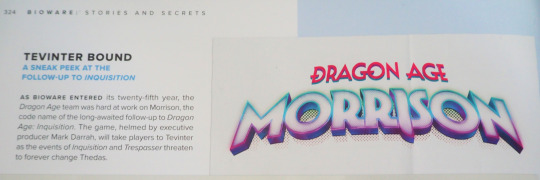
Along with this amazing retro-styled font of Morrison’s code name - that I’m totally going to use in future videos and thumbnails - we actually have a small plot synopsis on this working title.
It reads as followed: “Tevinter Bound – a sneak peek at the follow-up to Inquisition.”
“As BioWare entered its twenty-fifth year, the Dragon Age team was hard at work on Morrison, the code name of the long-awaited follow-up to Dragon Age: Inquisition. The game, helmed by executive producer Mark Darrah, will take players to Tevinter as events of Inquisition and Trespasser threaten to forever change Thedas.”
We’re going to Tevinter! Of course, we already knew that based on Trespasser’s ending, Tevinter Nights, and the developers already hinting that, but it is still very nice to see hear that in a plot outline.
In addition, the most interesting factor about this synopsis, is that for the first time BioWare have confirmed that “Morrison” is indeed the code name for the current Dragon Age project, which outrightly confirms that Jason Scheirer’s Kotaku article on “The Past & Present of Dragon Age 4” carries merit and truth to it, meaning that we can indeed trust the entire contents of Jason’s article.
Regardless, sticking with the 80’s retro theme, BioWare staff have themed shirts for the project, and they look absolutely amazing. Please, BioWare Gear Store release these one day, if at all possible, these designs are so good!

The book then goes on to show very familiar concept art that was showcased within the Gamescom behind-the-scenes trailer, however, this time, we have actual descriptions on each of the art pieces, and what they’re portraying. So, we don’t need to spend another 40 minutes speculating about what the pieces could show.

The underwater shot which we assumed to be Isabela accompanied by what looks like Dorian with a sword, an undead and a female dwarf, appears to showcase the Lords of Fortune, a newly-introduced faction within Tevinter Nights.
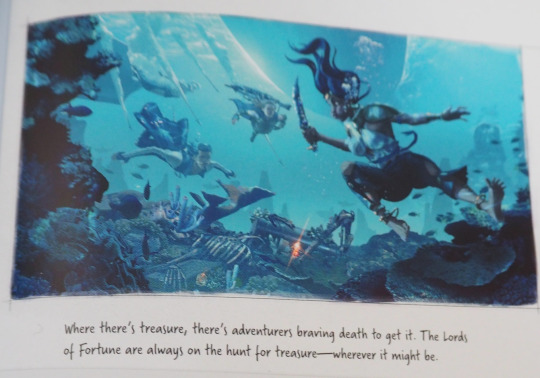
The synopsis says:
“Where there’s treasure, there’s adventurers braving death to get it. The Lords of Fortune are always on the hunt for treasure-wherever it may be.”

The next shot, which I speculated it as Tevinter’s capital city Minrathous, has a synopsis that says:
“The glittering hubs of Thedas are beacons of civilization and bulwarks against the night.”
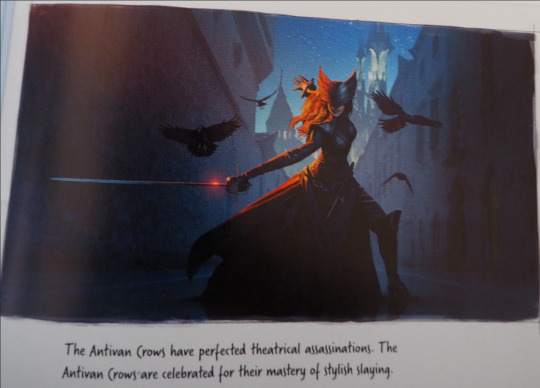
Following that, we have the mysterious Antivan Crow lady concept art with the synopsis:
“The Antivan Crows have perfected theatrical assassinations. The Antivan Crows are celebrated for their mastery of stylish slaying.”
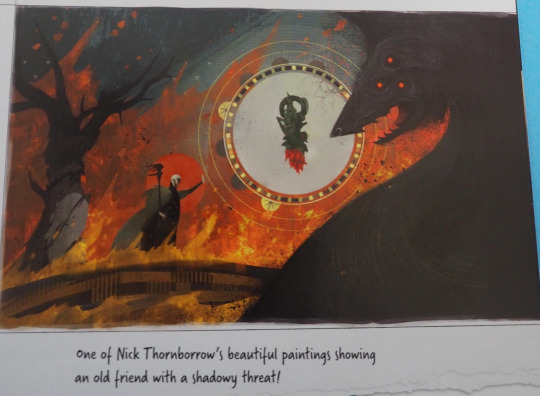
And then we have a most recognisable mural, one that many of us have spent way too long staring at, tinfoiling over its endless possibilities. The synopsis of The Dread Wolf Rises concept piece says:
“One of Nick Thornborrow’s beautiful paintings showing an old friend with a shadowy threat!”
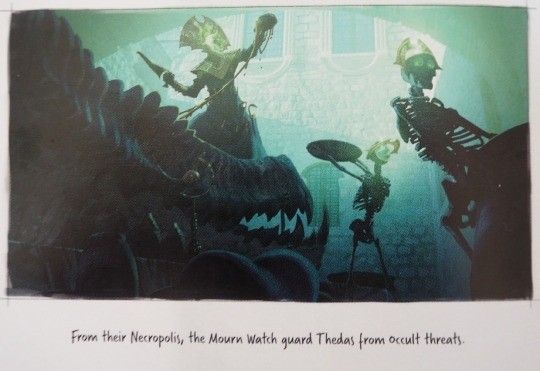
Following that, we have Nevarra’s undead operating on a dragon, with the synopsis saying:
“From their Necropolis, the Mourn Watch guard Thedas from occult threats”

And then we have – hold on, what’s this, a new piece of concept art? Roll on the tinfoil, I’ll read the synopsis first and then we can go from there, as it states:
“The Deep Roads teem with evils both new and old, known and unknowable.”
I won’t spend ages delving into a single piece of concept art, but we can see the Deep Roads with plenty of light coming from the surface. It’s a beautiful shot, that I’m sure is building a mood for potential locations in the next game.

The final concept art piece shown is one from the trailer, however, it’s not cut-off anymore. When it once looked like an evil Cetus, it now reveals something even more wicked than a sea dragon... A figure with multiple arms, red eyes, a curved headpiece, holding a spear. Is this an ancient God? Could it be Ghilan’nain? A Lovecraftian sea-hybrid-monster? Or is it just a crazy idea thrown together by a concept artist, because why not?
The synopsis is the most intriguing and provides a further context for the next Dragon Age game:
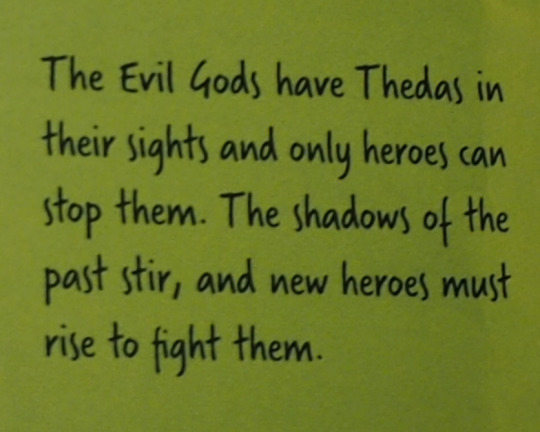
“The Evil Gods have Thedas in their sights and only heroes can stop them. The shadows of the past stir, and new heroes must rise to fight them.”
There are many “gods” in Dragon Age, the Old Gods, the Elven Gods, the Maker, the Titans, etc. You could certainly consider each of them to be evil too, but on a whim, with the whole “shadows of the past stir.” I’m sure this synopsis is referring to the Elven Gods, given Solas’s scheme that will return the Evanuris to Thedas once more.
Taking my tinfoil hat off for a moment, this book expertly describes concept art stages relating to BioWare, and I need to touch on what exactly these pieces could mean going forward, because they most certainly could just be conceptual drawings without much context for the next game.
The book quotes Dragon Age 2’s development regarding concept art, saying:
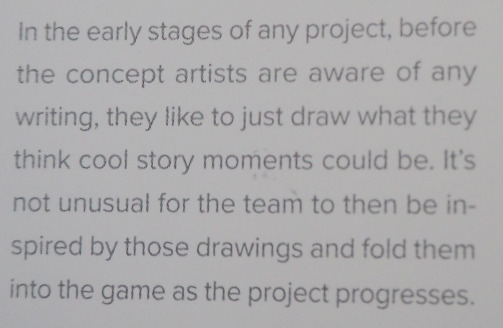
“In the early stages of any project, before the concept artists are aware of any writing, they like to just draw what they think cool story moments could be. It’s not unusual for the team to then be inspired by those drawings and fold them into the game as the project progresses.”
And, even further than that, Matt Rhodes, who is the Art Director of the next Dragon Age spoke a few words regarding Dragon Age: Inquisition’s conceptual art stages:

“As multiple teams worked on their corners of Inquisition, lead concept artist Matt Rhodes spent weeks creating images to help solidify and drive a vision of what the game could be.”
“It was partly to encourage and remind myself of what the potential of this project could be,” Matt says. “We all imagine the finished game. I wanted to get that on paper, to remind everyone we are making something that could be pretty cool.”
So, while we’re all so excited to see these amazing concept designs and imagery, and we love to correlate it all to the next game, remember that these designs are very early work building a vision for the next game, they’re just being used to represent what idealistically the developers would like the game to end up like, or what insane ideas the concept artists have for the game.
Many of these ideas won’t turn out in the final product, but it’s still so nice to see this work already.
Wolf Rook Book:
Moving on, we can put an end to a five-year mystery, we finally have answers on that enigmatic red “Wolf-Rook" book that Mark Darrah has teased for half a decade.

One of my first ever videos on this channel was delving into the early pages of this book, back then I had a hunch that this book was the next Dragon Age game’s early concepts and designs, like a shiny development doc for the team.
And I was on the right tracks, as followed:
“The book was an internal guide for developer and publisher eyes only that summarized the vision for Dragon Age: Inquisition’s follow-up, a project code-named Joplin. The Joplin project has since been revised to such an extent that its code name changed to Morrison, but the red book still contains plenty of ideas likely to appear in the next Dragon Age. While most pages remain highly classified, here are a few Mark said we can publish.”
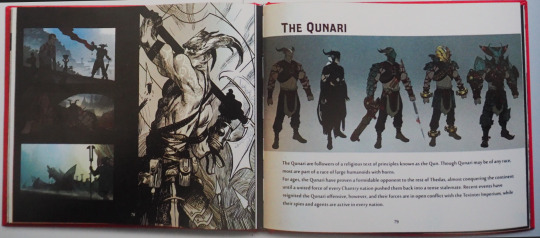
There’s a small description of The Qunari with some other concept shots, the paragraph reads as followed:
“The Qunari are followers of a religious text of principles known as the Qun. Though Qunari may be of any race, most are part of a race of large humanoids with horns.”
“For ages the Qunari have proven a formidable opponent to the rest of Thedas, almost conquering the continent until a united force of every Chantry nation pushed them back into a tense stalemate. Recent events have reignited the Qunari offensive, however, and their forces are in open conflict with the Tevinter Imperium, while their spies and agents are active in every nation.”

And at the bottom we have a Creatures double-spread page with different concepts very similar to those seen in Inquisition, the paragraph reads as followed:
“Animals, monsters and misplaced magical experiments: creatures stir apart from the conflicts and machinations flowing across the continent. Creatures range from the lowly nug up to the ultimate apex predator, the dragon. The next Dragon Age will feature our widest and most varied set of creatures to date. While often quite simple in implementation, creatures provide variety through differentiated animation and appearance.”
So, “Wolf-Rook” is still relevant, somewhat confirming that the work that went into Joplin, may cross over into Morrison, which is very exciting because Joplin’s vision for a Dragon Age title sounded amazing, so to hear aspects of that work pouring into this new project is absolutely fabulous. I had a hunch that the red book was still valuable to the current project, because we’ve seen a lot of “Wolf-Rook” teased this year, Mark Darrah has not stopped showing off his stash of red books. So, I’m very glad it’s here to stay for the current iteration.
Dragon Age Week:
Next up, we have an update to a story I talked about in March of this year, Mark Darrah teased a picture of his laptop with the BioWare Slack server shown at the bottom of his screen.

One of the channel-titles within the server was one by the name of “DA Week”, and thanks to this book, we know what “Dragon Age Week” actually is:
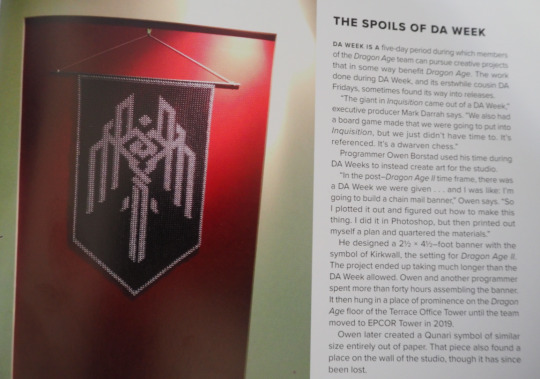
“Dragon Age Week is a five-day period during which members of the Dragon Age team can pursue creative projects that in some way benefit Dragon Age. The work done during DA Week, and its erstwhile cousin DA Fridays, sometimes found its way into releases.”
“The giants in Inquisition came out of a Dragon Age Week,” executive producer Mark Darrah says. “We also had a board game made that we were going to put into Inquisition, but we just didn’t have time to. It’s referenced. It’s a dwarven chess.”
So, I do wonder what kind of ideas have come out of Dragon Age Week recently that has then ended up in the next Dragon Age. Hopefully, one day we’ll have a new book that tells us Dragon Age 4’s secrets and we can visit this topic.
New BioWare Vision:
Moving on to the final major update, thanks to this book, we have a greater understanding about the vision BioWare have going forward. According to General Manager, Casey Hudson and Dragon Age, Narrative Director, John Epler.
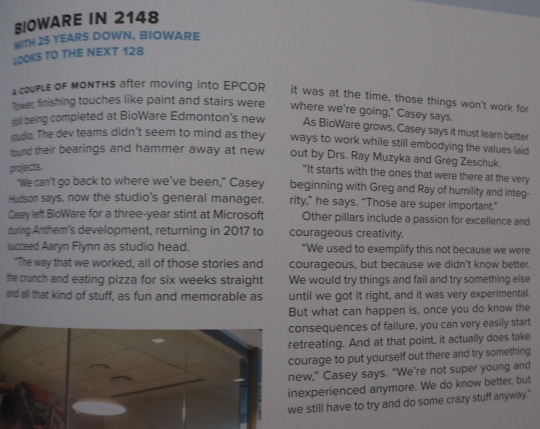
Casey Hudson spoke on the “old” BioWare and how their changing paths to a “newer” BioWare:
“We can’t go back to where we’ve been,” Casey Hudson says, now the studio’s general manager. “The way that we worked, all of those stories and the crunch and eating pizza for six weeks straight and all that kind of stuff, as fun and memorable as it was at the time, those things won’t work for where we’re going.”
As BioWare grows, Casey says it must learn better ways to work while still embodying the values laid out by Drs. Ray Muzyka and Greg Zeschuk.
“It starts with the ones that were there at the very beginning with Greg and Ray of humility and integrity,” he says, “Those are super important.”
Other pillars include a passion for excellence and courageous creativity.
“We used to exemplify this not because we were courageous, but because we didn’t know better. We would try things and fail and try something else until we got it right, and it was very experimental. But what can happen is, once you do know the consequences of failure, you can very easily start retreating. And at that point, it actually does take courage to put yourself out there and try something new.”
Casey says. “We’re not super young and inexperienced anymore. We do know better, but we still have to try and do some crazy stuff anyway.”
John Epler shared on the change going on within BioWare:

“I am excited for what the future holds. I think BioWare is changing. I think we’re at a crossroads where we can either accept that and move into the new BioWare, or we can try to cling to the past. We have to be respectful of our origins without being constrained by them. It’s an exciting time and I’m really looking forward to what the next five years brings.”
“’I’m one of those people who is probably going to be here until they have to literally wheel my desiccated corpse out of the building, because I love working here and I love the people I work with and I love getting to come into work every day to have long, detailed conversations about how eluvians work.”
All in all, I’m incredibly excited and optimistic for BioWare’s future, they’re aware of their flaws, while knowing what makes them great. They seek to humble themselves, while changing direction, they want to avoid crunch while being experimental. I think we’re going to see the company bloom when they inevitably release the next Dragon Age, and I am totally here for that.
Dragon Age Day
Before I leave you, Dragon Age Day is quickly approaching, and it seems BioWare have plans this year. EA Community Manager, Jay Ingram tweeted about fans asking questions for the Dragon Age team, in prep for plans on Dragon Age Day. I’ll link the tweet down below, so you can ask as many questions as you’d like! It seems that BioWare may stream on Dragon Age Day, so do watch out for that, and give them a follow on their Twitch, also linked down below:
https://twitter.com/JayKingIngram/status/1325197450907275264
https://www.twitch.tv/bioware
Regardless, this is where we part ways. There was so much that this book uncovered, I highly recommended picking It up for yourself, it’s truly worth it to any BioWare fan. There was also some future Mass Effect stuff, but I’m saving that for a future video that I’ll do at the start of the new year. And I most likely will do future videos on other topics revealed in this book.
#dragon age 4 news#dragon age news#biowar#bioware 25 years#dragon age update#morrison#joplin#wolf rook book#mark darrah red book#mark darrah slack server#dragon age week#next dragon age#concept art#dragon age concept art#dragon age 4#dragon age 4 concept art#the dread wolf rises#da#da news#tevinter bound#imperium#tevinter#thedas
36 notes
·
View notes
Photo
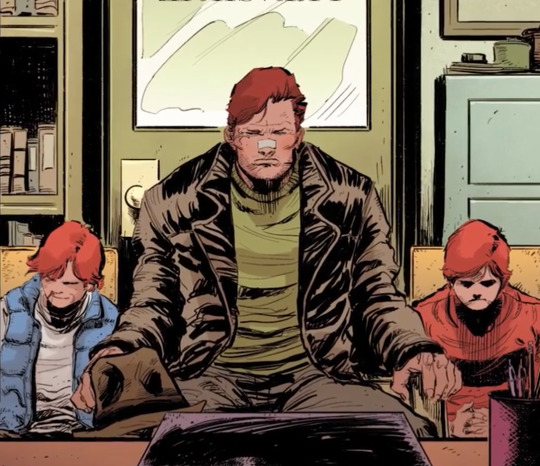
[ID: A panel from the upcoming Daredevil Annual. Jack Murdock is sitting in what looks like a principal’s office, facing the viewer. Sitting next to him on the right is a young (pre-teen-ish-looking) Matt Murdock, looking sullen, and sitting next to Jack on the other side is an identically young Mike Murdock, who is smirking and has a bloody nose. Jack looks displeased.]
“[This will be] the first solo story starring Matt Murdock’s twin brother, Mike Murdock [...] Mike knows Matt better than anyone, and will pose a very legitimate threat to him in the coming months. This self-contained story sets up some key plot threads that will pay off down the line in the main Daredevil series.”
-Marvel’s solicitation for the Daredevil volume 6 Annual, on sale August 26th
So. I haven’t said much about the current run, and I do promise to write about it at some point, since there are a few things I'd like to discuss. But let’s start with this! Last month I posted a very vague solicitation for the upcoming Annual issue, along with a link that I strongly encouraged people to click on. If you clicked that link, it would have taken you to a video that would have revealed to you that finally, after nearly two years, Mike friggin’ Murdock is returning to the series.
Scroll up! Look at him! Look at them all together! That’s a frame-worthy panel. Beautiful.
Obviously, I’m very excited. I’m also nervous, because I’ve had major issues with Zdarsky’s characterization in this run, and Mike is such a new character that he feels extra vulnerable to shaky writing, but I am mostly very, very excited. This issue, it seems, is going to not only include Mike, but actually star him! (As he deserves!) It is going to contain flashbacks, meaning we’re finally going to get a glimpse into Mike’s version of Daredevil history (you may remember me yelling about that idea during Soule’s run)! And we’re finally going to learn what Mike’s been up to since he joined up with the Hood and the Kingpin way back at the end of #608.
The description of the issue, provided in the video and quoted above, implies that Mike will be entering this run as an antagonist. This doesn’t surprise me. Mike thinks Matt wants him dead, he has (foolishly) allied himself with some bad dudes, and even his bizarre existence itself is dangerous to Matt. And who knows what might be uncovered delving into his memories? The original, pre-pandemic solicitation Marvel released for this issue suggested that it would forever change Matt and Fisk’s relationship, and while the “everything will change!!!!” claim is made all the time, it’s still worth wondering about. That said, I’m assuming-- or at least, hoping-- that Mike won’t be a full-on villain in this run. His relationship with Matt is extremely complicated and deserves in-depth exploration and development. I hope we get that, but even if we don’t, Mike should at least be not entirely comfortable making his brother miserable. Solicitations tend to exaggerate story details because their aim is to get fans intrigued and excited; Mike was implied to be a threat and a villain in all of the solicitations for his introductory arc too, and the actual story was a lot more nuanced than that. I hope the same will be true here.
The next issue in the main series (#21) goes on sale tomorrow. I’m hoping for a dramatic Mike entrance on the last page to set up the Annual, but if not, I can guarantee some Mike-themed yelling at the end of August.
If anyone needs a refresher on Real Boy Mike Murdock, his introductory issues are Daredevil volume 5 #606-608, and I also have a tag that covers the whole story arc. Additionally, if there’s anyone out there who knows all about Real Boy Mike but hasn’t read the original Mike Murdock Saga, I highly encourage you to check it out. It starts with Daredevil volume 1 #25 and is essential Daredevil reading. (I also have a post summarizing it here.)
32 notes
·
View notes
Text
Hi :)!!! I’m sending this through submission because halfway through writing this via ask I got stressed about the character count and splitting this into multiple asks is not something I have the energy for today.
I’m not in the middle of reading any fics right now (very out of character for me), but a few of my favorite fics this year have been… *sweats and rifles through my ao3 bookmark list because this is really hard to just pick a few*. "body’s in trouble" [Nolan Patrick & Nicklas Backstrom, Nolan Patrick/Travis Konecny] by cloudsandpassingevents, “(break something old) to build something new” [Danny Briere/Claude Giroux] by Lake(beyond_belief), “i might (even know what to say)” [Danny Briere/Claude Giroux] by callabang, “you know you’re a terrible sight but you’ll be just fine” [Jake Guentzel & Knowing Himself, Jake Guentzel & His Brothers, Jake Guentzel/Jared McCann] by heartequals(savvygambols), “little spoon” [Quinn Hughes/Thatcher Demko] by mundanememory, “Your Will In My Hand” [Sidney Crosby/Evegni Malkin/Anna Kasterova] by Sparcck, “Closed Fracture” [Sidney Crosby/Evgeni Malkin] by lightgetsin, “Lean on Me” [Mitch Marner & Matt Martin, Mitch Marner/Auston Matthews] by sheyrenawyrsabane, and “Morning to Wake You” [Sidney Crosby/Evgeni Malkin] by oflights.
Oops, that was definitely more than a few. I know for a fact that you’ve read some of those (like “little spoon” for example!!), but I figured I’d send some of my favorites.
A lot of these are sort of centered on the process of growing up, along being able to acknowledge who you are and be comfortable with it, just because *shrugs* it’s sort of where I’m at right now. I’m 1000% sure you’ve read most of these, but I’m going to tell you why I love them anyways.
This might be recency bias, but “body’s in trouble” actually took me out, literally mowed over me emotionally. I basically had to write an essay when I commented on it, but if I’m going to try to summarize (which I’m guessing isn’t necessary because it seems like the sort of thing you’d have already read), I LOVED how human the characters were and how genuine their struggles felt. Like, Nolan was trying to figure out how to let himself be happy, and *pained screaming* it was such a raw moment when he started to change his thinking on that and I think the author did such a clear job of getting you into his head and mindset and walking you through it so the moment also felt intensely personal as a reader.
“Morning to Wake You” is also just so incredible!?!?!?!! I feel like it’s a characterization of Sid that’s somehow simultaneously really consistent with how he’s usually portrayed in fic and also really different. I think one of my favorite things about the fic is that I loved all the relationships in it, not just the main pairing. I absolutely loved the friendship between Colby and Sid, the way Mario was clearly someone with whom Sid felt same and at home but also like an adult, and the little moment between Sid and Tanger. In a fic about growing up and growing into yourself, I thought the development and investment in making those relationships so rich really enhanced the fic because Sid (from the way I read it) was really learning not just how to let himself be human for himself but also let other people witness it. I’m not doing a very good job of articulating why something about this fic feels so unique, but it’s one of my absolute favorites. If guess if I’m trying to summarize, the grey area and realness of the uncertainty combined with the process of figuring out how to grow into yourself but let that growth take root in one’s life really makes this just absolutely wonderful.
“(break something old) to build something new” makes me unhinged every single time I read, albeit for completely different reasons than “body’s in trouble” or “Morning to Wake You”. I can’t put a finger on what makes me love this fic so much, but I guess in some ways it’s a later in life, less fraught but just as significant story of learning to make space in your life for the things that make you happy/feel like you’re home. It’s not an examination of the question of allowing yourself happiness in the same was that “body’s in trouble” is, but it’s a story that just makes you feel good. I think every reader likes vicariously through characters in fic, so I think this is what I read when I’m craving that comfort of belonging, home, and family. Danny has a good thing, and it’s a story of him realizing that and then actualizing it. By putting Danny both at a time when he’s so established and secure in his life yet still at a crossroads, it makes him think about what he has and what he wants. It takes him longer for him to be able to articulate what it is he wants than it does for the reader, but that’s the journey (that sort of makes it feel like it’s drawn out–it’s not, it’s more of a Danny just has to think about it before he figure it out). I also love the way the author wrote the supporting characters on this one!!!! I think it just really adds dimension to the story and is the first thing that really cultivates this atmosphere of family that’s woven through the fic, right there for when Danny finally sees it. (In regards to supporting characters, I’m so overly invested in the storyline between Cameron Briere and his bio lab partner in which he finds his first non-hockey friend.)
Anyways, I hope you’re having a great day/morning/evening!!!! I really enjoy reading your fic recs and I also really enjoyed spewing out an.. oops… eight paragraph ask :)
okay HELLO i tried to format this in the way the made the differentiation between the post submitted by @kingdom-of-the-shades and my response clear but uhhhhhh if i didn’t do a good job lmk and i’ll edit the post. i also tried to hyperlink all the fics you mentioned for ease of finding for anyone interested!
i do see a common theme in these fics based off what i’ve read the and descriptions of the rest (i’ve read half of them though i did immediately read the callabang fic when i went to grab the link because it was very much my shit and i love ao3 user callabang’s writing)
also you really called my out about body’s in trouble because i literally waws scrolling through the hockey rpf tag like the sunday paper and fully had to tweet about the tags because it was very much my kind of fic. absolutely back what you’re saying about it, because i agree completely. feeling very feral about the scene were nolan takes nicke fishing because it’s such a full circle moment (nolan putting what nicke’s taught him into practice AND using it to help nicke when he’s going through it? fucking......GOD)
i haven’t read the other two you called out specifically but you making a compelling argument for both of them (probably gonna read that danny/claude fic sooner rather than later because i absolutely ADORE fics where the supporting characters add to the fic)
#personally i would love it if i regularly got messages like this in my inbox this is so lovely#thank you so much for taking the time to share all this with me!#recs for gritty#fic rec#submission
3 notes
·
View notes
Note
In your one fic, Desire and Lust, what does Grimmjows Lamborghini look like? Just curious if you have an actual picture on hand
SPOILERS ABOUT DESIRE AND LUST AHEAD
Ooooooo! I was just ogling some Lambos! I’m about to go on a rant!!!
Sexy, in a word; his Lambo looks like a sleek, sexy sportscar. I put a TON of thought into his car specifically, buckle up! The first description I ever added was Grimmjow telling Ichigo its make, model and color: “‘A Lamborghini Murciélago. Sportscar, solid black paint, custom build but it still looks like a Lamborghini. It should have been parked out front if ya saw it.’” Ichigo soon goes outside and sees a car in the parking lot and we get the detail that it is ‘jet black’ too: “A sleek, jet black sportscar was parked in the farthest spot to the left of him.” Ichigo also finds out that there is a trunk and the engine is up front and that the car is modified and heavier than usual for its model. So the base image we have to imagine is a sportscar model like:


This is a stock Lamborghini Murciélago, which is actually one of my small model Lambos, this is the almost the same as Grimmjow’s HOWEVER, he did make significant modifications but most of them don’t show outright. He kept with a sleek and classy black theme, the interior is almost completely black suede, panther and silver accents as noted by his mentioned satin seat covers with panthers on them. (the panther on his key-chain was from his wrecked Jag) Most details of the mechanical modification process reside in the chapter called Flashback - Motor Head other details are scattered through multiple chapters but I’ll summarize anyway!
Most of his car from the outside looks the same as it would stock except that it is longer (length) by maybe six inches or less (don’t think I gave exact dimensions) which works to create a backseat since he seated the new v8 motor/engine for it in the front under the hood, meaning a v12 (stock) motor’s worth of space contributes to the space to make a two-person conjoined backseat and a small trunk because that’s a big-ass motor. The glass and metal on the back of that small model car are a hatch which would open to show the motor but instead in his Lambo shows a small upholstered trunk and the back-side of the backseat. There are still small windows on either side to see outside from the backseat with black-out tinting. The windshield is not tinted or not fully tinted. The windows on the passenger and driver doors also have black-out tinting. The headlights and taillights do not have tinting and are LED. The back hatch’s glass I have not mentioned but I would say it isn’t tinted or just barely. The glass is bulletproof and very resistant to breaking. Rear view mirror, side view mirrors (that lift with the doors), etc. stuff like that is all just stock. The gearshift might look different but I haven’t picked out a design though it is short. His Lambo can be started with a turn of a key or an ignition button with key inserted. The dash display is stock, I believe that’s mostly analog and features a tachometer, speedometer, secondary speedometer (digital - not stock), odometer, oil pressure and oil temperature gauges as well as all the other fun random lights that come up for different sensor thingies (like the ‘check engine’ light we all hate). It would be reasonable to assume there are a few extra lights for extra sensors in a heavily modified vehicle like this.
There was no need to change the flat hood of the car for the motor’s blower/supercharger (twin-screw) or the front features on the fender to consider ram air intake as this car already has this feature; the oncoming air is just rerouted inside to the front compartment instead of the rear. (some other Lambos you’ll see have hoods popping out on the rear panels for ram air to cool their huge motors) The modified v8 motor that Grimmjow installs is smaller and part of the total added length to the whole frame (six inches or less) is in the new engine compartment for easy of installation and maintenance on the motor. Grimmjow’s modifications to the transmission and drive train (front transaxel, all-wheel drive, semi-auto) are all under the car and don’t really show; there are skid-plates. His car has only two doors. The butterfly doors are stock-looking and lift up at a slight angle but inside them his custom locking assembly (with sliding bars like a vault door) is heavy so there is a large hydraulic cylinder needed to hold them up under the front edge of each door. Grimmjow (in very recent chapters) thinks he needs even bigger cylinders. Only the tinted driver and passenger windows can roll down and up. Most of the cosmetic and superficial features of Grimmjow’s Lamborghini we can assume are kept the same/stock black theme. We find out that the Lambo used to be blue, it is a shiny jet black now so it was repainted [by a shop Grimmjow took it to]. Grimmjow’s car didn’t have seatbelts until recently - to please Ichigo; assume they are black. The center console and upholstery/interior is black suede/leather (Lamborghini has a special name for this type I think) with maybe a few very small silver accents like handles or buttons. The seats are stock black suede too but covered with black satin with a panther on each (probably around the high back), front and backseats. The deck/stereo interface in the cockpit should be digital but I might’ve written it as analog so far. I never gave details about the rims but I would say they are painted matte black and somewhere between normal and true low-pro because I don’t think Grimmjow would want true low-pro ones. The tires I never describe much either but they’re black-walls probably just street/sport, all the same size and width in front and back - around 21 inches tall and are also wide (315s or 325s??? *shrug* lol). As you can tell I had plenty of thinkin’ to do about rearranging everything else so the tires and rims kinda went under my radar. Grimmjow seems like the kind of guy to have a nice border around his license plates (front and back) but I’ve never written that in, would probably be solid chrome with a panther or two.
Oh my god I have to stop myself. I go on and on about this fucking dream-car.
This is a really rough sketch (sadly only from the front) of Grimmjow’s Lamborghini:

At this time I don’t have any other sketches to share BUT that doesn’t mean one isn’t coming out in the future. *brows* One day I might actually draw something of a diagram or the Lamborghini from the outside - it would be a hell of a task either way.
Lamborghini Murciélago © Lamborghini
#Grimmjow Jaegerjaquez#Grimmjow Jeagerjaques#grimmichi#Bleach#Desire and Lust#fanfiction#writing#vehicle#car#Lamborghini#asks#spoilers#FD Art Things
12 notes
·
View notes
Photo

Being a dungeon master can be intimidating, especially if you��ve never done it before. However, it can also be an incredibly rewarding experience that boosts self confidence. Running a session (let alone a campaign) is a lot different than being a player, but there are only a few things you need to know in order to be labeled a great DM.
Plot Line
Develop a main goal
Have purpose
Come prepared... but not too prepared
MAIN GOAL - When it comes to developing a plot line for an entire campaign, I see two ways of doing it: having a complicated main plot where 90% of the time is dedicated to solving/working through the main plot, or, having a simple main plot with lots of room for sub-plots. I’ve seen the first done really well, but I am personally a fan of the latter. It leaves so much more room for player character development as they navigate through the NPCs and the diverse set of problems thrown at them. On the contrary, I find that running complex campaigns without subplots is more focused than the other type.
An example of a complicated campaign plot would be a political scheme plotted between all of Faerun to rise Tiamat from her slumber. The party knows this, and they travel around the land in search of answers. They have the same goal in every town they visit, and everything they do is centered around stopping (or aiding) the rise the primordial goddess.
An example of a general plot with many subplots would be that the party has to light the hearths of a multitude of villages to prevent a celestial attack. They have time before this attack happens, and they run into other villages that need their help along the way. Maybe a woman’s daughter was taken? Or there is a cursed well that spits out an undead creature every once in a while that needs to be taken care of?
There is a difference between the two styles, and deciding what kind you want to run before you go into running your session is crucial. If you change midway, things can get confusing, or feel rushed.
This page is for novel writers, but it is extremely useful for developing a plot and taking your PCs into consideration when planning.
This video is centered around RPGs and goes through plotting step by step.
HAVE PURPOSE - Know how you want your campaign to go before you sit down in the DM’s chair. Understand your main goal, and where you want your players to be at the end of the campaign. Do you want them fighting an all powerful fiend? Maybe competing to be the rulers of an all new nation? Are they going to try and save the world? Once you have that, you can build the stepping stone to get them there: sessions.
Each session should bring them closer to the end goal. So, have a plan for each session. Make each session have a purpose, and make sure it relates somehow to the end goal. Do they need to be here to meet an NPC who will give them information? Is there a magical item that will help them on their journey? Is there an enemy or an ally to be made?
COME PREPARED - Walk in knowing the environment you will present like the back of your hand. Know (or have notes) on everything your players could potentially have access to in the area you drop them in.
Have NPCs ready to go with their stats in case they need to fight, have the map of the location so vividly in your mind that you could draw it half asleep. Place the NPCs in their proper locations. Many people think when they’re just starting off that they need to have a plan for anything their players will throw at them. I thought that too. But turns out, that’s not true. You just need a plan for every place your players could possibly go. Understanding this is a lot less stressful and will take a lot less time. You probably didn’t have a plan for your friend’s dwarf running headfirst into the chimney. But you know the location, the building, and the attitude of the NPC. That is efficient enough to figure out on the spot what happens to the PC. Was the building of sound structure? Maybe in your mind it wasn’t, so the whole thing comes crumbling down and everyone needs to make a dex save. Maybe it was of sound structure in your mind, and the PC bursts right through. But you’d decided that these woods are infested with elementals. So, time for the party to roll initiative.
Come prepared when it comes to the location and setting, but don’t try and prepare for what your PCs are going to do once they’re in it. Players do weird things sometimes, and sometimes subliminal messages aren’t received. So there was a murder in town and you mentioned a sketchy looking character with blood on his clothes walking around the tavern??? Well, your players want to investigate the victim’s husband instead because you described his mustache for a suspicious amount of time. I cannot stress this enough, this happens all the time. It can be frustrating, but you just have to follow them through what they want to do and adjust what you imagined to fit their decisions. If you have your NPCs and locations fleshed out, then that won’t be hard at all.
People think the DM is the one who controls the game, but not really. And in my opinion that’s the way it should be.
Quick and easy NPC stat maker.
Encounters
Balance
Making enemies
Distributing XP
BALANCE - Encounters need to be balanced. You don’t want them too easy, but at the same time you don’t want to have a TPK. I personally use the CR system. In general, the way to use the CR system is that you take the average level of players in the party should equal the CR of the creature/added total of the creatures. So, if you have level three creatures, it’s okay to have them fight a boss CR 3 insect. It would also be fine if they fought two CR 1 quadrones and two CR 1/2 Ambush Drakes. Fighting one CR 1 quadrone would be far too easy, but fighting a CR 5 Hulking Crab would wipe them out.
This system is built for 4-5 players, so aim a little less if you have 2-3 players, or a little more if you have 6+.
D&D Beyond has a great selection of official monsters as well as other people’s homebrew monsters.
MAKING ENEMIES - Whatever idea you have for a creature, especially if it is something out of other folklore, has probably been made into a 5e creature by someone somewhere. A lot of the time though, it isn’t balanced for your party level. So, you have to adjust it.
When it comes to adjusting official or other homebrew enemies, I always recommend looking at other creatures of the proper CR and adjusting the values. Maybe make that 4d8 damage just 1d8 damage? Or take away the fact that this creature can make 3 attacks. It’s all what you make it.
If you decide to create something entirely from scratch, draw inspiration from other creatures of the same CR needed for you party. Make sure you take into account the party composition to see what the party can handle.
Matt Mercer explains this really well in this short video.
DISTRIBUTING XP - This point is a bit controversial, but it can be used for the sake of realism (even if it is a fantasy game). Experience is relative, and shouldn’t be limited to fight scenes. Think about how experience goes in real life? What makes people grow? For most people, the answer isn’t anything physical. Give experience points for trying to learn a new trade or making a connection with another character.
Take their backstory into account too. Maybe there is a PC who has never killed before. The first time they kill someone would be a big deal and a major life event for them, as opposed to someone who is an assassin who has been killing since they were a teenager. And maybe that assassin has never had a true friend, so forming a bond with someone would be major character development.
This also accounts for enemies. The ranger who specializes in killing the undead should earn less XP than the monk who is encountering them for the first time. It is an eye opening and probably terrifying experience for the monk, but for the ranger it’s just another day at the office forest.
Attitude
Be confident
Listen to your players
BE CONFIDENT - Being a DM is a performance. You are playing different characters and creating a story for the rest of your group to enjoy. Not to put anyone under pressure, but if you’re going to be the DM, you’re going to be the star of the show. People’s entertainment depends on you.
Now, with that being said, there are an infinite amount of ways to DM. You can speak mainly in descriptions and simply summarize the main point of what the NPSc are trying to say as an indirect type of DMing. Or, you can take on the voice of the NPC and have full fledged conversations with the PCs, a more direct approach. One is not better than the other; it’s all a matter of personal preference. Me? I like the indirect way since I suck at doing voices, and two people in my group like playing that way while the other two prefer the more direct approach. It’s a toss up really. You just have to decide what you want to do and own it. Whether you decide on the direct or indirect way, the choice isn’t going to make a huge difference on how much fun the party has. The deal breaker is how well you sell it.
Have a strong voice. Be confident in what you’re doing. If you seem confused or nervous, your players are going to sense that and absorb it. So, just fake it til’ you make it. You may have no idea what is going on or why, but neither do they. If you throw a dragon at them just to keep them busy so you can plot something really fast, they’ll have no idea as long as you make it seem like it was intentional. Remember, they don’t know what is supposed to come next. They don’t know what’s inside that boarded up cottage, so how can they tell you that that they find wasn’t supposed to be there?
Here is an excellent link that describes the different types of playing and DMing.
LISTEN - This is the most important part of being a DM in my opinion. The whole reason you’re able to put on this story is because of the people playing with you. They are who you do it for, so make them matter.
Incorporate the PCs’ backstories into the sub-plots or the main campaign. Maybe something in their background is the reason why only they can defeat the Big Bad™? Or, what I find to be more thoughtful, take obscure details about each character and make them a central part of a session without the player even knowing it.
In my campaign I took the party deep within the woods, where they stayed in a small, flourishing village. The village was a sanctuary in the middle of a dry and dying forest. Turns out, the main villains had captured a celestial and was draining it’s power in order to feed the land. The three villains (A wizard, a sorcerer, and a warlock) bound the celestial and locked it underground in a cell that could only be opened by dropping three objects that contained the blood of the binders in the ditch above the cell. The celestial was able to send mind controlling insects into the town so they could possess civilians and have them look for the three objects that could set the celestial free.
The party knew what was going on with the possession, and they noticed since the beginning that the possessed people were drawn to one PC in particular. In the end, the necklace that specified PC had (and had since childhood) was the object that contained the binding sorcerer’s blood, and that was the final piece to release the trapped celestial.
That whole session was centered around one PC without them even knowing it until they end. They played a huge part in a session because I used a minor detail in their character backstory to my advantage. The whole party loved it and talked about it for weeks. People create characters and write backstories because they care about them, and the best thing you can do as a DM is to acknowledge and respect that character and your player’s work as much as they do.
You’re creating a world for your PCs to react to; you’re not writing a novel. Make their choices mean something. Even if you want them to go right, let them go left. Don’t let them go left and give them the same scenario they would have had if they’d gone right. Players can see when you’re railroading them into doing what you want them to do, and it is disheartening and discouraging. Why would they care what their character did if it didn’t matter anyway? Why should they think about the outcomes, or try and figure out the riddle? From what I’ve observed, this is the biggest in-game issue that tends to make groups dissolve.
That was a really long post, and I thank you for reading it until the end. I hope everyone took something away from this guide and that those just starting to DM or who are thinking about it feel more comfortable going into it.
41 notes
·
View notes
Text
So, which spells do we think Caleb got from the scrolls?
I’ve compiled a short list based on what we know he also has and what could make Caleb cry with happiness when he saw them, and say that he’d been looking for these for a very long time, and that they’d be good for the group. We also know it’s not Shield, since he bought that spell later in the episode. Also what I’m considering, although not all that much, is what kind of spells the High Richter would’ve even had. Spells in bold are my bet for the spells.
1) Mage Armor (1): I was thinking that one of them might be Mage Armor. You touch a willing creature who isn't wearing armor, and a protective magical force surrounds it until the spell ends. The target's base AC becomes 13 + its Dexterity modifier. The spell ends if the target dons armor or if you dismiss the spell as an action. This spell lasts 8 hours, so it would be particularly helpful for Mollymauk and Nott, but not so much for anyone else.
2) Magic Missile (1): I don’t think we’ve seen Caleb using this spell, and it’s pretty much a stable of having a low level Wizard. He probably has spells that are more powerful than this one, but I had to put it on the list. It’d be helpful because he’ll be able to attack more than one creature at once, but its a relatively weak spell, and probably not one he’d get too excited about.
3) Arcanist’s Magic Aura (2): I think this one might’ve been the MOST helpful in their current situation, but that also means that Caleb probably would’ve used it on The Beacon directly after getting the scroll. You place an illusion on a creature or an object you touch so that divination spells reveal false information about it. The target can be a willing creature or an object that isn't being carried or worn by another creature. So basically that night that Caleb spent sleeping in the basement wouldn’t have had to happen, so it’s PROBABLY not this spell, but I can imagine that Caleb would want this so I’m putting it on the list.
4) Detect Thoughts (2): Now THIS is almost certainly one of the spells. There’s a very long description about the exact abilities of this spell, but to summarize: For the duration, you can read the thoughts of certain creatures. When you cast the spell and as your action on each turn until the spell ends, you can focus your mind on any one creature that you can see within 30 feet of you. If the creature you choose has an Intelligence of 3 or lower or doesn't speak any language, the creature is unaffected. This would be helpful for the group, make Caleb excited, AND be something the High Richter would’ve possibly had in her house. I’d bet money that this was one of the spells on the scrolls.
5) Invisibility (2): Very very helpful, although mostly for those in the party who can’t use disguise self (Beau, Molly). A creature you touch becomes invisible until the spell ends. Anything the target is wearing or carrying is invisible as long as it is on the target's person. The spell ends for a target that attacks or casts a spell. Since they’re doing a lot of sneaking, this would probably be a very helpful spell.
7) Magic Weapon (2): This is a great spell that could help anyone in the group (maybe not Fjord or Molly since their weapons are very likely magical already). You touch a nonmagical weapon. Until the spell ends, that weapon becomes a magic weapon with a +1 bonus to attack rolls and damage rolls. The Mighty Nein may be leveling up but they’re still relatively weak, so this buff will probably be super helpful for Beau or Yasha, our big damage dealers at the moment. Not to mention that it’d be helpful if they end up fighting something that’s immune to non-magical attacks.
8) Misty Step (2): Now this one is a favorite spell of mine, and I’d like to think that Caleb would really like this one even if its more helpful only for him and not necessarily for the whole group like he seemed to think the spells would be. Briefly surrounded by silvery mist, you teleport up to 30 feet to an unoccupied space that you can see. I’m pretty sure you can only teleport yourself, not another person with you, but Matt’s been pretty homebrew with Wizard rules so far this game, so it’s possible he would allow Caleb to bring Nott with him maybe if he was holding her. Anyways, I love this spell so I put it on the list.
9) Ray of Enfeeblement (2): This is a GREAT SPELL that would absolutely give them advantage (not gameplay advantage but still) in any fight against a physical fighter, which so far they’ve seen for a majority of their fights. A black beam of enervating energy springs from your finger toward a creature within range. Make a ranged spell attack against the target. On a hit, the target deals only half damage with weapon attacks that use Strength until the spell ends. Since they’re for the most part pretty squishy still, this will very likely be a vital spell, and I can ABSOLUTELY see Caleb getting excited over this one. It’s my vote for the other scroll simply because of how useful it could be to every single person in the party during fights (especially him, the squishiest).
10) Rope Trick (2): Now it might not be a GREAT idea to put Jester’s backpack inside here, I’m still a little fuzzy on how extra-dimensional spaces work, but this will be a great place for short rests, or if they need to hide from people. You touch a length of rope that is up to 60 feet long. One end of the rope then rises into the air until the whole rope hangs perpendicular to the ground. At the upper end of the rope, an invisible entrance opens to an extra-dimensional space that lasts until the spell ends. It lasts for an hour, and up to 8 people can fit in there, so with only 7, the Mighty Nein would all be able to be safe in this little pockety dimension, making it a very useful hiding/protecting spell. Obviously since you have to climb a ROPE to get to the top, it won’t be super great for protecting unconscious party members or NPCs but I mean, Horace could definitely chill in there for up to an hour if people come looking for him.
Now obviously these aren’t ALL the spells Caleb doesn’t know, just 10 ones I think are most likely to be one of the two that he found in the scrolls. I could be completely wrong or completely right, and I’m super excited to find out which. Message me if you have thoughts!
33 notes
·
View notes
Text
THE CHRISTIAN AND WAR
William D. Barrick
Professor of Old Testament
Answering the question, “Should a Christian be a member of the military?” is the best way to elaborate on “The Christian and War.” On the positive side, the military emphasizes the importance of moral character for its leaders. On the negative side, the military is a profession in which killing may be a part of one’s responsibility. Four possible positions to take regarding this difficult issue are nonresistance, Christian pacificism, just war, and preventive war. Also at stake is the Christian responsibility to submit to governmental authority as indicated in Romans 13:1-7 and 1 Peter 2:13-17. New Testament analogies comparing responsibilities of Christian living with being a good soldier seem to point to the legitimacy of Christians being part of the military endeavor of their country. That plus other factors support a Christian’s being involved in military service. Yet the conscience of each Christian must prevail in making this difficult decision about the issue, “Should a Christian be a member of the military?”
* * * * *
Introduction
The issue of war and Christian involvement in military service is so extensive that it is necessary to limit the scope of this study of “The Christian and War.” Its literature dates from the earliest years of church history,1 with a history too vast even to be summarized here. Obviously, biblical exegesis and Scripture rightly interpreted must inform any resolution of the issues. Therefore, at least to look at what the Bible has to say about the topic is imperative. A focus on one basic question is the best approach: “Should a Christian be a member of the military?”
Since the question deals with “a Christian,” the emphasis should be upon what the NT has to say about the matter. However, the question itself did not originate with the Christian church. Indeed, the issue predates the Christian era. Even in OT times believers faced the problem of involvement in war. Certainly Abraham had given some consideration to the issue prior to commencing armed action against Chedorlaomer’s coalition of kings (Genesis 14). He engaged the kings in battle in order to free his nephew Lot and his family.2 Since both testaments are the inspired Word of God and “profitable for teaching, for reproof, for correction, for training in righteousness,” 3 a consideration of the teaching of the whole of Scripture on this issue is in order. “If Christians are to have clear attitudes towards war, they must first come to some understanding of the subject in the Bible, including the Old Testament.”4 However, in order to keep within the length restraints of this article, the study will limit itself to what is revealed in the NT. The OT has much to say about war, but it is not often directly pertinent to the specific question upon which this study will focus.
Military service is a brotherhood of sorts because a fighting unit must be as one if it is to succeed under fire. It is a strange brotherhood since, in the passing of time, even enemies will regard themselves as having a bond forged in the horror of battle. That is why American and Japanese veterans can meet at Corregidor or Iwo Jima and British, American, and German veterans congregate on the beaches of Normandy fifty years after the fact and shed tears together for departed comrades in arms. Such a brotherhood, however, is not the supreme brotherhood that believers enter through the gospel of Christ.
Military service involves keeping faith with a vision for a nation’s freedom and greatness. Nothing less than total commitment is required of a soldier. Semper fi is more than a motto for the United States Marine Corps, it must be a way of life—and death. Without total commitment, a man or woman cannot serve as a good soldier in any army.
It is the modern military that finds new slogans that emphasize personal development and individual potential. “Be all that you can be” does not focus on selfless commitment to one’s nation. Such a trend is not unlike the transition experienced in churches that offer a need-based ministry rather than upholding selfless commitment to the Word of God and the cause of Christ.
This push for personal development is associated with a renewed emphasis upon core values and ethics in the military. Every member of the United States Army carries a laminated card entitled “Army Values.” On it are the following words:
Loyalty: Bear true faith and allegiance to the U.S. Constitution, the Army, your unit, and other soldiers.
Duty: Fulfill your obligations.
Respect: Treat people as they should be treated.
Selfless-Service: Put the welfare of the nation, the Army, and your subordinates before your own.
Honor: Live up to all the Army values.
Integrity: Do what’s right, legally and morally.
Personal Courage: Face fear, danger, or adversity (Physical or Moral).5
Both of my sons serve in the American military. Nathan is now a major in the Army and Timothy is a captain in the Marine Corps. Both have made it clear that moral character is vital to proper military leadership and that values-training in the current military is something that committedChristian officers are uniquely qualified to teach. General John A. Wickham, a past Army Chief of Staff, wrote about the importance of moral character for military leaders. He noted that “one does not develop character in the heat of battle or a moment of crisis. Character grows out of the steady application of moral values and ethical behavior in one’s life.”6 The Christian home and Bible-teaching churches are the best institutions for producing individuals with high moral values and consistent ethical behavior.
If moral character were the only issue, Christians would find military service a simple decision. However, the challenge is far more complicated than that. A number of arguments for a Christian to stay out of the military are as follows:
The military is a profession in which killing people may be a part of the job description.
The military can be a very worldly environment in which Christians can face all kinds of temptations. . . .
Jesus said to love your enemies. . . . In contrast, the military is about hitting the enemy before he hits you.7
Some of the hard things about being a Christian in the military include:
Family separation during deployments can make it tough on the family.
Family separation can be a source of temptation. . . .
It’s hard to be an evangelical witness on the job. . . .
There is a lot of peer pressure to drink alcohol, curse, and party “on the town” in places of ill repute.
You have to be politically correct. . . .
I might have to kill someone someday. . . .8
War is violent and terrible. During the American Civil War in 1862, Confederate troops held a low ridge called Marye’s Heights near Fredericksburg, Virginia. Union troops sent to assault Marye’s Heights had to cross exposed ground. Wave after wave of Union troops charged but were cut down before they could reach the Confederate lines. Over 12,000 were slain. Watching the battle, Gen. Robert E. Lee turned to Gen. James Longstreet, whose men were holding Marye’s Heights, “It is well that war is so terrible; else we would grow too fond of it.”9 Any man, woman, or child who has experienced the horrors of war firsthand knows how awful the toll of war can be. That toll is perhaps the strongest argument (outside Scripture itself) for devoting time to an examination of the Christian’s involvement in the military.
The violence of military conflict creates a natural tension with the normally peaceful nature of Christian living. One must not forget the significance of nonviolence in Christian character and behavior, but must remember the following biblical truths:
Non-violence is preferable to violence (cf. Rom 12:17-21).
Non-violence is more consistent with Christian morals (cf. Matt 5:9, 38-48; 1 Tim 3:3)
However, the Scriptures themselves do not allow the believer to seek peace at any price (cf. John 2:13-17; Acts 23:1-10; 1 Cor 4:19-21; Gal 2:5-14; Eph 5:11; 2 John 9-11; 3 John 9-10). Granted, the situations to which Scripture passages refer are nonmilitary in nature. However, there is a line to be drawn when standing up to the forces of evil. There are occasions in the course of Christian life when there cannot be peace—when it would be unchristian to compromise or to fail to act unpeaceably toward someone. Sometimes Christians shun confrontation while using Christian love, compassion, and mercy as an excuse. That can result in direct disobedience to Scripture—as in the matter of exercising church discipline against a sinning brother or sister in Christ.
Francis Schaeffer declared that “to refuse to do what I can for those under the power of oppressors is nothing less than a failure of Christian love. It is to refuse to love my neighbor as myself.” 10 He went on to say that was why he was not a pacifist: “Pacifism in this poor world in which we live—this lost world—means that we desert the people who need our greatest help.”11 Peace at any price is never right, whether it is in the realm of spiritual warfare, church discipline, or government.
Does a posture in defense of truth and morality include military action? Christian apologists have offered four major views in the search of answers to this question.
Four Views
Nonresistance.
The title chosen for this view reflects the words of Matthew 5:39: “Do not resist him who is evil.”12 However, although physical force may not be employed to resist evil, spiritual means may be enlisted to combat evil (cf. Luke 6:27-36; Rom 12:21; 2 Cor 10:3-4; 2 Tim 2:1-2; Jas 4:7; 1 Pet 5:8-9). In this view the Christian is dedicated to the work of the gospel as his/her highest priority as a citizen of a heavenly kingdom. One may pray for peace and must support the government, but must never be involved in any action that takes the life of another human being. If the unbelieving government needs to fight a war to fulfill its obligations to defend its citizens, let it do so, but no Christian should be an active member of combat troops.13 Christians holding this viewpoint ought to request non-combatant status when fulfilling a military obligation.14
Christian pacifism.15
The basic philosophy undergirding the nonresistance view is also foundational to the Christian pacifist viewpoint. The key difference is that the Christian pacifist will not serve in the military in any role. Whereas the nonresistance adherent may serve in a non-combatant role, the Christian pacifist must be a conscientious objector.16 Views that tend to pacifism rest upon texts in the Sermon on the Mount (cf. Matt 5:9, 21-26, 38-48). This viewpoint also relies on the Scriptural background of Matthew 5:21 in Exodus 20:13/Deuteronomy 5:17.17 The Christian pacifist believes that Christians are called upon to counteract this world’s warlike tendencies by promoting the spiritual love and peace which Christ exemplified.
Just war.
Adherents to the just war viewpoint have sought to establish guidelines to ensure the exercise of the military option in a just fashion. Those criteria include the following:18
A just cause is basically defensive in posture, not aggressive.
The intent must also be just—the objectives must be peace and the protection of innocent lives.
War must be a matter of last resort when all attempts at reconciliation or peaceful resolution are exhausted.
A just war must be accompanied by a formal declaration by a properly constituted and authorized body.
The objectives must be limited. Unconditional surrender or total destruction are unjust means.19
Military action must be proportionate both in the weaponry employed and the troops deployed.
Non-combatants must be protected and military operations must demonstrate the highest possible degree of discrimination.
Without a reasonable hope for success, no military action should be launched.20
Although the just war position may seem fairly straightforward, it is, in reality, a very complex matter. Consider the possible combinations and interrelationships of the factors: (1) unjust cause and just means; (2) just cause and unjust means; (3) unjust cause and unjust means; and, (4) just cause and just means. Remember, too, that all of these possible combinations apply to at least two different sides in the conflict: friend and foe.21 How should each of the criteria apply to each side in the conflict? “Since human beings of a mind and will are involved on both sides of a conflict, it is often hard to determine what is the just cause in asserting or shunning a ‘just’ hegemony.” 22 War is never simple. It is always complex. It is not a blackand-white matter, nor even gray—if anything, it is blood red.
Preventive war. This view is an extension of the just war position. It supports preemptive action or first-strike options (even with nuclear weapons, when necessary) if an enemy’s aggression is thought to be imminent and unavoidable. Preventive war adherents also advocate the use of military force to recover territory unjustly seized by an aggressor.23 Indeed, such aggressors may be struck without warning while they are residing in their conquered territory in apparent peace.
Governmental Authority in the New Testament
Just war advocates normally base their position on passages revealing the divine origin and approval of government and its functions. Romans 13:1-7 is the cornerstone of this viewpoint. Consider a question in regard to this important text: May Christians wield the government’s biblical sword? The apostle Paul represents the government as a divinely constituted authority (vv. 1, 2).
It was to Paul a matter of little importance whether the Roman emperor was appointed by the senate, the army, or the people; whether the assumption of the imperial authority by Caesar was just or unjust, or whether his successors had a legitimate claim to the throne or not. It was his object to lay down the simple principle, that magistrates are to be obeyed.24
Even though the civil and military assets of the Roman Empire would be employed to slaughter Christians, the Holy Spirit directed the apostle to instruct believers in Rome to submit to the Roman government. Even though the emperors of Rome lived profligate livessteeped in immorality and debauchery, their authority was legitimate. Every believer was to submit to that authority unless the demands of that government directly contradicted divine command (cf. Acts 5:29). All other “resistance is a violation of God’s law and meets with judgment.”25 According to Everett Harrison, the seeming contradiction of Romans 13:1-2 and Acts 5:29 might be handled in two different ways: (1) assume that the apostle merely presents the norm stripped of any possible biblical exception26 and (2) apply the principle of Romans 8:28, trusting that God eventually will “bring good out of apparent evil.”27
The text is also explicit on the role of God-ordained governmental authority: the sword is to be employed in avenging28 wrong (vv. 3, 4). As John Murray explains,
The sword is so frequently associated with death as the instrument of execution (cf. Matt. 26:52; Luke 21:24; Acts 12:2; 16:27; Heb. 11:34, 37; Rev. 13:10) that to exclude its use for this purpose in this instance would be so arbitrary as to bear upon its face prejudice contrary to the evidence.29
Government cannot be passive nor can it avoid actions that might involve the taking of life in order to accomplish its Scriptural mandate. “The Biblical state protects against tyranny from within (crime) and tyranny from without (invasion).” 30 Interestingly, this fact is recognized by all four major views concerning Christian involvement in the military. For some, however, the Christian must not take part in any avenging action, although they would allow non-Christians in the government to do so.
Subjection to governmental authority is not just to avoid punishment for civil disobedience. Subjection is a matter of maintaining a good conscience with regard to one’s obligation to God (v. 5).31 This involves active monetary support for the government by all legitimate forms of taxation (v. 6). Not even the Christian pacifist is given the option of refusing to support the government financially in its military actions.32 Whether the Christian is on the front lines of battle pulling the trigger or serving as a non-combatant or remaining at home as a conscientious objector, each must pay the taxes for that war. By those taxes, every Christian is a participant in that war and the killing that takes place in its progress. An interesting fact is that the very taxes that Paul exhorted the Roman Christians to pay eventually financed Paul’s own execution.
Paul was not the first to experience this irony. Christ Himself ordered the payment of taxes to Caesar and was put to death by Roman soldiers paid by those taxes. Historically, the church has carefully defined a balance of duty for Christians in these matters. Augustine’s statement is representative:
So if anyone thinks that because he is a Christian he does not have to pay taxes or tribute nor show the proper respect to the authorities who take care of these things, he is in very great error. Likewise, if anyone thinks that he ought to submit to the point where he accepts that someone who is his superior in temporal affairs should have authority even over his faith, he falls into an even greater error. But the balance which the Lord himself prescribed is to be maintained: Render unto Caesar the things which are Caesar’s but unto God the things which are God’s (Mt 22:21).33
First Peter 2:13-17 lends support to the submission so carefully delineated in Romans 13:1-7. Peter states quite clearly that such submission is the will of God (1 Pet 2:15). The one who rebels in this area rebels against God. Although this study focuses upon the matter of military service, recognition that the role of the civil police in society is also a function of the avenging arm of government is relevant. If a Christian must avoid military service, neither must that Christian be a police officer. Christian pacifists sometimes attempt to distinguish between police action and military action, allowing the former while denying the legitimacy of the latter.34
Does the NT give any examples of Christians acting as officers of government who bear the responsibility of wielding the avenging sword of Romans 13:4? Are they approved or disapproved? Were converts required to resign from such positions when they entered the early church? Consider the following:
Cornelius was a centurion, a military officer of high rank in a battalion of Roman fighting men (Acts 10:1). Although he was a soldier on active duty, he is described as “devout” (,ÛF,$ZH, eusebs, v. 2), a term that, at the least, describes a man of high moral character and piety. He became a convert to Christ and was baptized publicly (v. 48). The Scripture is silent about his status from that point on.
Sergius Paulus was a proconsul in the Roman government in Cyprus (13:7). A proconsul’s (a Roman provincial governor) authority included ordering the execution of criminals and deploying Roman troops in battle when needed.35 He became a believer (v. 12). The Bible gives no record of any resignation from his office upon becoming a Christian.
Erastus (Rom 16:23) was an active city treasurer even after his conversion. As a government officer he managed the funds that would be utilized in the execution of criminals and the payment of police. As an active official, he could be called upon to wield the Roman sword of authority both figuratively and literally.
Zenas (Titus 3:13) was an active Christian lawyer. In the Roman system of the courts, he played a role in the application of the avenging sword—the application of capital punishment.
Somewhat related to the matter of Christians bearing a sword is the instruction Jesus gave to His disciples for taking prudent measures for self-protection in Luke 22:36. Although it might seem at odds with His teaching in Matthew 26:52, it should be obvious that the two are not mutually exclusive. Luke 22:36 “more likely indicates, not a reversal of normal rules for the church’s mission, but an exception in a time of crisis (cf. ‘but now,’ alla nyn). Jesus is not being ironic but thoroughly serious.”36 In regard to this passage, Loraine Boettner declared, “If we lived under such conditions we would have occasion to become much better acquainted with weapons than we now are.”37
On the basis of the Gospels and the teachings of Jesus, a number of arguments supporting the believer’s participation in the military are the following:38
Jesus’s approval of a king who waged war against wicked people (Matt 21:33-41).
After Peter cut off the ear of the servant of the high priest (John 18:11), Jesus did not tell him to rid himself of his sword, merely to resheath it—for future use?
In John 18:36 Jesus stated that it would have been proper for His disciples to defend His kingdom with swords if it had been an earthly kingdom.
New Testament Analogy
Throughout the Bible the Holy Spirit led the writers in the choice of legitimate metaphors for describing both the character of God and the character of the believer. It is axiomatic that inherently evil vocations or activities are not employed for such descriptions. The simile of the thief (1 Thess 5:4; 2 Pet 3:10; Rev 3:3; 16:15) in eschatological judgment is not an exception to this principle. The text does not say that the Lord is a thief, only that He will come as a thief comes (viz., unexpectedly). The metaphor of a thief is reserved for one who is anti-Christ (cf. John 10:1, 10).
The metaphor of warfare, armor, and the soldier himself is common throughout the NT. The Christian puts on the armor of God (Eph 6:10-20). Each believer is to be a “good soldier” (2 Tim 2:3-4). Believers are to be active participants in waging spiritual warfare (2 Cor 10:1-6). If being a soldier was as inherently wicked as being a prostitute, a thief, or a murderer, the Holy Spirit would not have permitted the writers of the NT to employ that metaphor.
It is hardly conceivable that the Scriptures should present the Christian life under a symbolism having to do so distinctly with soldiering and warfare and at the same time repudiate the reality for which that symbolism stands as always and everywhere wrong.39
In addition, that Christ Himself will engage in actual, blood-shedding, lifetaking warfare when He returns to set up His kingdom (Rev 19:11-21) is significant. He cannot be the Righteous One, the Holy One, if war is inherently evil and the combatant’s role satanic. When He comes, the Lord will instruct His people to engage in that future warfare (cf. Obad 15-21). Would He demand His people to commit sin? Of course not! Therefore, warfare cannot be inherently sinful.
Christians in Military Service
Why should a Christian serve in the military?40 Are there any positive points to be advanced for such service? Soldiers at war are serving in a situation that can only be described spiritually as desperate. Men occupy a position where death is a real possibility for them to experience—a horrible and agonizing death by violent means. Such men are in desperate need of the gospel and the ministry of Christians. War itself creates an atmosphere of destruction and inhumanity. Violent deeds may bring out the very worst of the sinful nature’s traits. Christians may need to stand in the gap in order to maintain decency, order, and just action.
Such a thing as a just war may also occur. World War II could very well make the claim of being a just war.41 Doubtless, there are others and will be others. War is the result of sin (cf. Jas 4:1-2), but war itself is not necessarily sin. “The one who takes original sin seriously knows that life is lived on a descending escalator and that it is a tough job even to stand still.”42 It becomes all too clear to any sound theological thinking that the rejection of the employment of force might be a recipe for anarchy or tyranny attended by multiplied suffering and death for many innocent people. That is why all four major views of Christian involvement in war uphold the right of a state to maintain a standing army and to order it onto the field of battle. The issue is the degree of individual Christian involvement. “All violence is caused by sin, but not all violence is necessarily sinful—it may even be the occasion of virtue when it calls for courage and self-sacrifice.”43 In short, the need is for men who will stand for God and for His Word in the world—including in the military among soldiers who need the gospel.
The Christian’s Conscience
Certain principles of Christian action apply even to considering participation in the military. Each believer is accountable to God (cf. Acts 5:29). No believer can leave this decision to someone else. Each Christian has liberty to determine the will of God for his or her life (cf. Romans 14). Part of that determination must take into account the dual citizenship of the Christian as being in the world while not being of the world (cf. John 15:19; 17:11).44
Consider the matter of prayer. Do Christians pray that the Lord Jesus will return soon? In point of fact, we are praying that
the whole pitiless machinery of war may go forward to bring, if possible, a speedy conclusion. It is mangled bodies, tortured minds, orphaned children that we are concerned with. There will be unstable children growing up to be parents of unstable homes, till the third and fourth generation, as a result of our war.45
Do Christians pray for the deliverance of Christians from persecution in places like China, the Sudan, and Pakistan? Do Christians pray for the release of the missionaries held hostage in Colombia? What will be the outcome if those prayers are answered by God? Christ eventually will come to judge those who have rejected Him and the gospel concerning Him. God may choose, in the meantime, to utilize war in China, the Sudan, or Pakistan to accomplish the deliverance of His people from persecution. The answer to these prayers may be war. Do believers know what they are praying? Any who have prayed these prayers cannot claim to have hands free of blood just because they have refused to be a soldier in their nation’s military.
Christians should not too hastily claim the role of “peacemaker” (Matt 5:9). Such a role is not necessarily antagonistic to the role of a warrior. Christ’s employment of the Greek term (,ÆD0<@B@4`H, eirnopoios) is the only Scriptural occurrence. Outside Scripture it is found only as a description of Caesar who wielded the sword of military might to produce the pax Romana. 46 A true peacemaker will not make peace at any price nor will he or she shun the employment of legitimate force to produce that peace.
Conclusion
The issue is not one that can be decided quickly nor easily. No believer dare take the matter lightly. It is a difficult matter that involves the conscience of believers and perhaps even their Christian liberty. Note John the Baptizer’s response to the soldiers who inquired what they should do as works that would appropriately result from repentance:
And some soldiers were questioning him, saying, “And what about us, what shall we do?” And he said to them, “Do not take money from anyone by force, or accuse anyone falsely, and be content with your wages.” 47
They were not told to resign from their vocation as soldiers, but to be content in that position with the wages it paid. Their behavior was to be just and honest—even while remaining soldiers. They were not instructed to resign, the life of a soldier not being viewed as inimical to true repentance. Ultimately, however, John’s instruction must be recognized as a pre-Christian declaration. Also, it was directed at those already in the military, not to those who might consider joining. These tensions have been recognized since the earliest centuries of the Christian church.48 The passage is offered here as a catalyst for further study. Has its teaching been revoked or revised by Christ or the apostles? What are its logical and theological implications in the context of all the rest of Scripture’s teachings on this subject?
The issue of war might be ignored for a time, but every individual must, at some time, come to grips with it personally. Peter Craigie described his encounter with the issue in the following way:
When I was a theological student, I worried about the “holy war” problem in the OT and sought the advice of a professor for further reading. He recommended one or two commentaries and von Rad’s Der heilige Krieg im alten Israel (“The Holy War in Ancient Israel”). I went off to study and found a mass of material of linguistic, historical, and cultural interest. But I found nothing which spoke to my problem, the theological anxiety I had about the identification of God with war. One cannot generalize from a single experience, yet I have met a large number of clergy since that time who experienced the same problem in their theological training.49
It is up to each believer to go to the Word of God in order to study this issue for himself/herself. Each believer’s good conscience is at stake in the decision. It is the opinion of this writer that the just war viewpoint offers the greatest consistency with the overall view of both the OT and the NT. Such a viewpoint ought not to be imposed on any individual believer, however. Perhaps the Scripture’s silence about any resignation from military service by converted soldiers on active duty is but an indication that the matter falls in the realm of freedom of conscience rather than the realm of absolute morality. That is the best answer to the question, “Should a Christian be a member of the military?”
━━━━━━━━━━━━━━━
1 An excellent compendium of key discu ssion s in the pa st is to be fou nd in Arthu r F. H olmes, ed., War and Christian Ethics (Grand Rapids: Baker, 1975). The volume includes declarations of pagan philosophers as well as le ade rs in Christen dom (Plato, Cicero, Athenagoras, Tertullian, Origen, Lactantius, Ambrose, Augustine, Bernard of Clairvaux, Thomas Aquinas, Martin Luther, John Calvin, Erasmus, Menno Simons, Francisco Suarez, Hugo Grotius, John Locke, Immanuel Kant, G . W. F. Hege l, Lyman Abbott, Reinhold Niebuhr, Robert Drinan, and Paul Ramsey). Cf. Roland H. B ainton, Christian Attitudes Toward War and Peace: A Historical Survey and Critical Re-evaluation (Nashville: Abingdon, 196 0). See als o A dolf Harnack, Militia Christi: The Christian Religion and the Military in the First Three Centuries, trans. by D avid McInnes Gracie (P hilad elph ia: Fortress, 1981), a work first published in German in 1905.
2Cf. Robert A. Morey, When Is It Right to Fight? (Minneapolis: Bethany House, 1985) 23-25. In regard to the example of Abraham in Genesis 14, Lot and his family w ere not descendants of Abraham, therefore the action cannot be legitimized by appealing to the Abrahamic Covenant. Likewise, for those who would point to the uniqueness of Israel’s situation in the OT with regard to war, Genesis 14 was prior to Israel’s existence.
3 Second Timothy 3:16— all Scripture quotations are from the NASB unless noted otherwise.
4 Peter C. Craigie, The Problem of War in the Old Testament (Grand Rapids: Eerdmans, 1978) 16. This volume provides an outstanding study of the issue in th e OT in order to encourage a resolution to the problem of Christian involvement in militarism and war.
5 Headquarters, Department of the Army , “Army Values,” http://www.hqda.army.mil/ocsa/values.htm (30 Jan. 20 00).
6 John A. Wickham, Jr., “Leading—A Commentary,” Army Organizational Effectiveness Journal 1 (1985):6.
7 Nathan Bedford Forrest, a Confederate general, was reminiscing with Gen. John Hunt Morgan about their exploits in Tennessee and Kentucky in the summer of 1862. Morgan wanted to know how Forrest had captured the garrison and stores at Murfreesboro in spite of federal forces filling the surrounding countryside. Forrest replied, “I just took the short cut and got there first with the most men.” His answer has been enshrined as “I got there fustest with the mostest.” Cf. Clifton Fadiman, ed., The Little, Brown Book of Anecdotes (Boston: Little, Brown and Co., 1985 ) 214. Forrest’s statement aptly describes the nature of military engagement and the concept of preemptive strike.
8 Capt. Timothy Edward Barrick, personal communication, 7 Feb 2000. The downing of Iran Air 655 by the USS Vincennes on July 3, 1988, is an illustration of the final point made by Capt. Barrick. In the midst of a firefight with Iranian gunboats, the Vincennes mistook the civilian airliner for an attacking military aircraft and s hot it d own with surface -to-air missiles ta king the lives of 290 civilians from six nations.
9 Fadiman, ed., The Little, Brown Book of Anecdotes 348.
10Fran cis A. Schaeffer, “The Secular Humanist World View V ersus the Christian Wo rld View and Biblical Perspec tives o n M ilitary Prepa redn ess,” in Fran cis Schaeffer, Vladimmir Bukovsky, and James Hitchcock, Who Is for Peace? (Nashville: Thomas Nelson, 1983) 23.
11 Ibid. Schaeffer uses the illustration of the obligation of Christian love to stop (by any means necessary) a big man from beating a tiny tot to death, if one were to come upon such atrocious conduct (23-24 ).
12 Matt 5:39 is best interpreted as a reference to personal interaction with other individuals in daily conduct, not interaction between armies or governments in a time of war.
0 notes
Text
Pantone Luxury with Serenity, Spa-like Experience
New Post has been published on https://www.designinfo.in/blog/color-management-solution/2019/pantone-luxury-with-serenity-spa-like-experience/2766
Pantone Luxury with Serenity, Spa-like Experience

PRODUCTS-
Deep Sea Luxury Bath Salt – Rose Garden

https://www.designinfo.in/tcx-swatch-card-individual/pantone-17-5513-tcx-swatch-card-deep-sea-Buy-India-1428.html
Deep Sea Luxury Bath Salt – Lavender Mystery

https://www.designinfo.in/tcx-swatch-card-individual/pantone-14-3207-tcx-swatch-card-pink-lavender-Buy-India-2563.html
“This is a mesmerizing luxury bath salt that comes in two scents, lavender, and rose. Just add one cap of the bath salts in your bathtub, and you will have the most relaxing spa-like experience at home. The bath salts will make your skin look younger and will make you feel refreshed and uplifted. The product will be shipped with 450 grams of bath salts per unit”
Today in the 21st century we live in a world where global economies are constantly growing, markets are expanding, and market competition has intensified like never before. We no longer live in a time where markets were just physical locations. With the industrial revolution boosting the production of goods and the advent of the internet, today in the 21st century, we now have access to Digital Markets. We are spoilt for choice even when it comes to picking something as small as a pen to something as big as a five-bedroom Villa. According to a recent study done by Harvard Business School Professor Clayton Christensen, 30,000 new consumer products are launched annually, and a staggering 80% of them fail, while only a mere 20% succeed and make a name for themselves. With hundreds of companies trying to beat each other, so that their product is the one chosen, what makes one company have the upper hand over the other? Why have corporate giants like Coca Cola, Nestle or Sunsilk been able to be the choice of millions of customers worldwide over and over again, whenever these customers are in the supermarket, faced with a row of considerable other options placed alongside? The driving factor for this consumer behaviour is largely influenced by product DESIGN. Product Design and packaging are integral to whether your product makes it or breaks it.
How does Design Info bring in the relaxing experience of Pantone?
We at Design Info don’t take this lightly. With an experience of 45 years in the design industry, and having excelled in supplying custom colour trend reports, fashion trend analysis, styles and accessories concepts for a number of clients, and Fortune 500 companies, we understand the importance of proper design representation to the global consumer audience. For this reason, we work with a large network of dynamic and creative textile, surface and graphic designers who develop custom artwork, prints, patterns, logos, and designs using the best TPG textile Pantone books. Our design team endeavours to meticulously tailor and create any design based on our clients’ specific requirements. We also spend a lot of time with our clients to properly understand their aims and what experience and emotions they wish their products to evoke or convey to its consumers. Since we constantly strive to deliver our clients with the utmost results and satisfaction, we are constantly crosschecking and analyzing current fashion trends, thoughts, social influences, anthropological and artistic events and feeding it into our efficient cultural triangulation system to improve our understanding of current and future trends, to serve our clients better.
Artists of Pantone Serene Colors
At Design Info our artist and designers look into every aspect of what a design or piece of art must invoke to its target audience. We draw inspiration by letting ideas flow, finding inspiration from everyday activities, analyzing present and emerging trends to attract customers not only in the present day but also in the near future.
Luxury Start-ups with Pantones Choice of Color
We understand Mr. Allister that your start-up Deep Sea-Luxury Bath Salts is set to launch 3 months from now on and you were looking for the best design inspirations to go with your product. We are pleased to say that as soon as we received your sample product and spoke to you regarding what the product is about, we brought together our senior-most Pantone designers and trend analyzers to study and come up with a report of what would be the best design and colour combinations that would work brilliantly with this wonderful product you wish to introduce to the global market. Before getting into the details of the design and explaining the colour combinations we have shortlisted for your product, I would like to remind you of the description and aims you wish to achieve, that you mentioned in the memo you had sent us,
Even Packaging is a Luxury to Pantone
Keeping in close consideration to what you provided us in your memo and to the product, we have come up with several things we would like to discuss with you. At first we would like to bring to your notice that since this is a bath product which will be kept in the bathroom or alongside wet areas, we suggest we go with a plastic bottle packaging rather than plastic packets reasons being, firstly, because it will improve customer experience of using the product since they will find it easier to keep it in the container itself and being plastic it won’t get wet in the bathroom unlike a cardboard packaging. Secondly, the plastic container will serve as a reusable container after the product is over, which can act as subconsciously engaging stimuli towards the product even after the product is over for its user. And third and most important the plastic container will give a glossy effect to the design on the container, attracting customers towards your product.
Which Pantone color schemes to use for luxury goods?
Moving on I would like to discuss the colour schemes and combinations we saw fit for this product. Keeping in mind what that the key aspects this product wishes to invoke (a spa-like feel, luxury, organic, sea salt, youth, radiance, healthy, refreshing, relaxing) we have structured a colour combination each for both the products keeping in mind present and future trends and thought processes. Since colours have a deep role to play in how the customer perceives the product psychologically, these are the colour schemes we deemed to fit the best
Deep Sea Luxury Bath Salts – Rose garden
For the Rose Garden, we want to let the design do the talking and still and make it appealing to the customer right away. For that reason we’ve chosen to go with a colour combination of Peach amber (#FAA094FF) which is a lovely refreshing pink and Yucca a serene turquoise (9ED9CCFF) for the body, with the font in White (FCF6F5FF) and the font surrounded with a exquisite Habanero Gold, evoking a luxurious, expensive feel to it. (#FFD653FF)
Deep Sea Luxury Bath Salts – Lavender Mystery
For the lavender mystery, we want to go with a little darker but subtle colours to give both the products a slight contrast against one another. For the body we’d like to go with last year’s Pantone colour of the yea, that is continuing to catch eyes, Pantone Ultra Violet (#5F4B8BFF) and a beautiful young Blush (#F5C7BBFF) with the font in a almost mystic Elation (#DFDCE5FF) with a complementing Vanilla Custard (#F0E1B9FF) for the border surrounding the font.
Summarizing Luxury movement with Pantone Support
The colours used above have been proven to induce emotions and feelings of class, luxury, radiance, cool mood, calmness, richness, and relaxation. According to our foresight and research by experts, we have predicted that these colours will be ones that should be the top grossing colours for this year and the year 2019. Our inspiration for the colour choices for this product came from the cool monsoon season, which inspired us to keep the colours cool and timid while not being too loud and distracting. The decision to go with slightly misty shades worked perfectly with the concept we were trying to deliver. These colours would look great both with a gloss finish or a matte finish. But in my professional opinion, I would personally suggest you go for the matte finish as it will give the product a more exquisite feel to it. We at Digital Info use the latest in printing color calibration technologies for all our products and all output gets a stringent quality check before the final packaging. We can confidently say that our colour reproduction and colour accuracy is of the highest standards and will be exactly what you expect to see and nothing lesser because, along with our printers, we also use the best in class industry quality ink. This is one reason why for years Digital Info has been able to boast about our customer satisfaction rates. It is because we have always maintained the highest standards for our work and never compromised or settled for less. With this, I can confidently say that Digital Info will be of best service to you and your business venture and will be the start of your company’s growth towards greatness. We will be waiting for your confirmation.
#pantone#pantone luxury#pantone serene#pantone sereniity#pantone tcx#Color Management Solution#Pantone#Product Report
0 notes
Text
On the 6th Day They Were Given Language: Consciousness and Self-hood
“I would say that selfhood as we humans normally conceive of it emerges as we master language. As Whitehead says in “Adventures of Ideas” (I summarize), the account of the 6th day should be written, “He gave them language, and they became souls.” I think we can make distinctions between degrees of nonconscious experience (particles, molecules, plants), conscious experience (animals), and self-conscious experience (logos possessed humans). I think Sartre’s definition of selfhood is a description relevant only to language using creatures such as ourselves.” — Matt Segall
The above quote comes from process philosopher, Matt Segall. He was responding to a question from a commenter on facebook a little while ago (I had saved the conversation because I tend to do that when I read interesting things) who was looking for a little clarification with regard to the differences between “self-hood” and “consciousnesses.” The commenter references Sartre’s definition of self-hood and I think Matt’s reply was very smart and helpful.
…
Print above by Jessica Eaton
On the 6th Day They Were Given Language: Consciousness and Self-hood was originally published on TURRI
0 notes
Text
Moment of Inertia, Issue #6 | A Newsletter's Newsletters
The content for Magnitude & Direction and Moment of Inertia doesn't come out of nowhere; I find articles from all corners of the internet, social media, and very frequently these other newsletters that I love reading every week.
_______________________________________________________
A Newsletter's Newsletters
The articles and events I share in Magnitude and Direction come from a bunch of different places. Some things I find on Facebook or Twitter. Other things get sent to me from readers like you (thanks to everyone who's done that in the past, and I hope you keep doing it in the future). And a lot of the content of my newsletters comes from... other newsletters.
The point of starting M&D was to serve as an aggregator: primarily for events in the startup, healthcare, biotech, etc. scenes, but also partially as an aggregator of the various articles and news stories I was interested in that appeared across myriad platforms. I know it can be fatiguing to manage so many information inputs, so I decided to centralize many of them into my own. The premise was, and is, "if you're interested in the kinds of things I'm interested in, hop on." (I do also try to broaden the offerings a bit, since if it was only stuff I was interested in there'd be one subscriber on this mailing list.)
While I'm glad to have you all here, virtually speaking, I wanted to take an opportunity to give some shout-outs to those newsletters that have inspired me and helped me build my own. This list is sort of a power-ranking, but the rankings aren't necessarily going to be in order, nor will the list be comprehensive, but I'll do the best I can.
* * *
The Prepared
This list literally couldn't start with any newsletter besides The Prepared. Run by my friend and fellow hardware enthusiast, Spencer Wright, this newsletter has provided the philosophical basis for how I run M&D. Click on that link, because Spencer has broken down his structure better than I would paraphrase it.
If you don't want to click that link (even though you really should), then let me summarize some of my key takeaways:
Strive to grow organically: Blasting your newsletter everywhere might increase your number of subscribers, but it won't increase the number of people interacting with your newsletter. Word-of-mouth recommendations are stronger than any other kind of promotion you can do. In the past, for me, that meant not even telling people that I had a newsletter (and somehow hoping they'd come across it eventually, which, to be fair, did happen occasionally). Now, though, I'm okay with letting that mouth be mine, as long as the person I'm talking to has very clearly indicated that they're interested in the kinds of things M&D offers (prior to me telling them about it).
Templates/categories are great: Spencer's newsletter follows the same template every week, breaking down the hardware, tech, and logistics world into specific (but not too specific) subsets. This approach, I imagine, makes reading each edition of M&D a little easier for all of you, since you know what section is coming next, but, more importantly, it makes writing it easier for me. I essentially write up each edition of M&D days (or sometimes weeks, upcoming events notwithstanding) before it gets sent out (also, this edition of MoI notwithstanding ). I can do this very easily because I'm just copy-pasting the content into a framework that I built in mailchimp a long time ago and just keep replicating.
There's other things I've learned from The Prepared, but I'll leave it at this, since I've got more newsletters to cover. I'll just say this: The Prepared is a great newsletter and if you are interested in the physical world, how it gets built, how it gets moved, and how it gets repaired, then subscribe to The Prepared.
Industrial Evolution
Run by manufacturing firm Plethora, Industrial Evolution is a newsletter I found not long after The Prepared. Focusing a little more on earlier-stage, more "futurist" science and engineering content than The Prepared, Industrial Evolution complements Spencer's newsletter nicely. Being interested in materials science and manufacturing myself, the articles I share from Industrial Evolution are most often focused on those topic areas, but the newsletter covers a lot more than that, including robotics and cutting-edge electronics development.
Web Curios
If nothing else, the sheer volume of content in Web Curios earns it a place on this list, but it's not just the amount of stuff that amazes me, a lot of this content is really interesting websites and applets that you just won't (trust me, I've checked) find in any other newsletter. Run by Matt Muir, the chief writer of web magazine Imperica, this newsletter skews towards social media news, but also includes a tremendous number of eclectic links. I honestly don't know how Matt et al. are roving the internet for these things, but I'm very glad they are. If you click on more of the non-tech links or weird apps and games in M&D, then you should subscribe to Web Curios too. Plus, they send their newsletter out on Fridays!
Laura Olin
Although the topical focuses of my newsletter and Laura's newsletter are very divergent, I'd like to think we have common ground as being two newsletters that are from individual people versus more abstract entities. (To be fair, Web Curios and The Prepared are also written in the voice of their chief architects, Matt and Spencer, but there are also more formal entities associated with each.)
There's a lot of links I don't click through in Laura's newsletter, but she also pretty consistently shares content that piques my historical and/or eclectic interests (sorry that's not a very illustrative description).
If you'd like to receive "a list of lovely and/or meaningful things in your inbox every Thursday" then I'd check out Laura's newsletter.
Recomendo
This one is a newer addition to my large set of weekly newsletters, but I've really been enjoying it. I think it's run by the creators of Revue "an editorial newsletter tool for writers and publishers" and it features 6 personal recommendations, one from each person. It's a lot of super-practical reviews and recommendations (we're talking vacuum cleaners and stuff, folks) and usually only one or two links is relevant to me, but I've already found some great tools - both physical and digital - thanks to this newsletter.
Gareth's Tips, Tools, and Shop Tales
I think I came across this newsletter via Recomendo, actually. It's the most recent addition to my weekly reading list and is kind of like a more hardware-focused version of Recomendo. It's pretty much exactly what it sounds like: a collection of workshop tricks, tips, and tools from a guy named Gareth. I don't know who exactly Gareth is, but I'm glad he's putting this material out here for the rest of us. If you're a hardware guy like me, I think you have to subscribe to this list.
Honorable Mentions
These newsletters are only a subset of all the newsletters I receive every week. There are a few others that I subscribe to that, I think, are more widely known than some of these so I'm going to list those below with a bit less description, but know that I diligently read all of these as well.
The Download by the MIT Tech Review: "Your daily dose of what's up in emerging technology" (and delivered every day! That's a lot of effort)
The Lattice by 3DHEALS: Run by healthcare 3D printing coalition 3DHEALS (and edited by me) this weekly newsletter is a pretty comprehensive look at all the different ways 3D printing and bioprinting is transforming healthcare.
Finimize: A great snippet of important financial news and topics, digestibly delivered for us finance laypeople.
Science Daily: Quite possibly every piece of science news is reported on this platform. I've selected the subsets that most appeal to me, but there's lots of other domains that are covered that I don't subscribe to. I also like that, following their synopsis, they almost always provide the link to the original paper (whether that paper is open access, though...)
Even with the Honorable Mentions, this list is still incomplete, but I'd like to think this is a selection of the newsletters that I've found to be most impactful to me. Since you're all M&D readers, I think at least some of them might be impactful to you, too.
0 notes